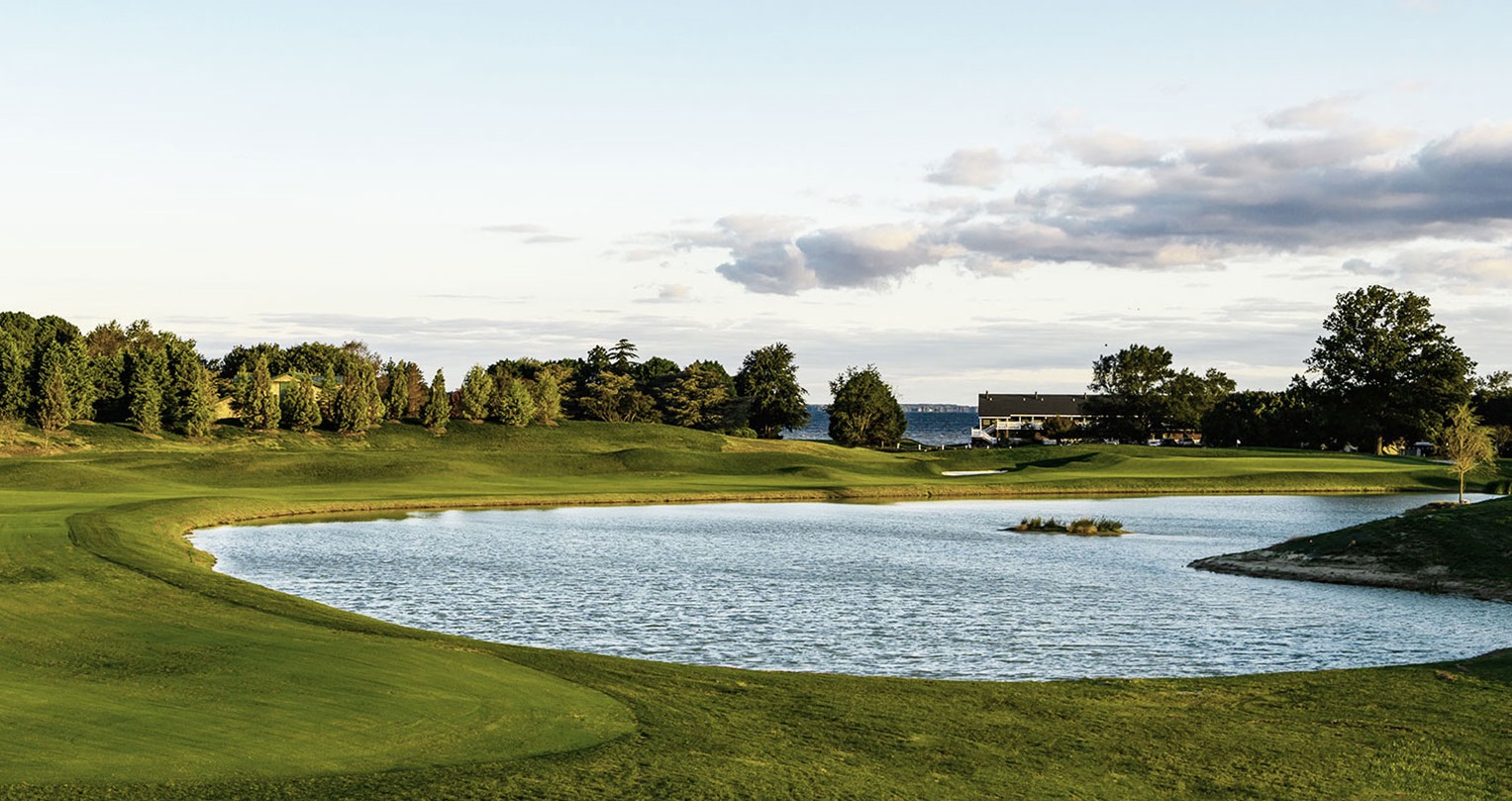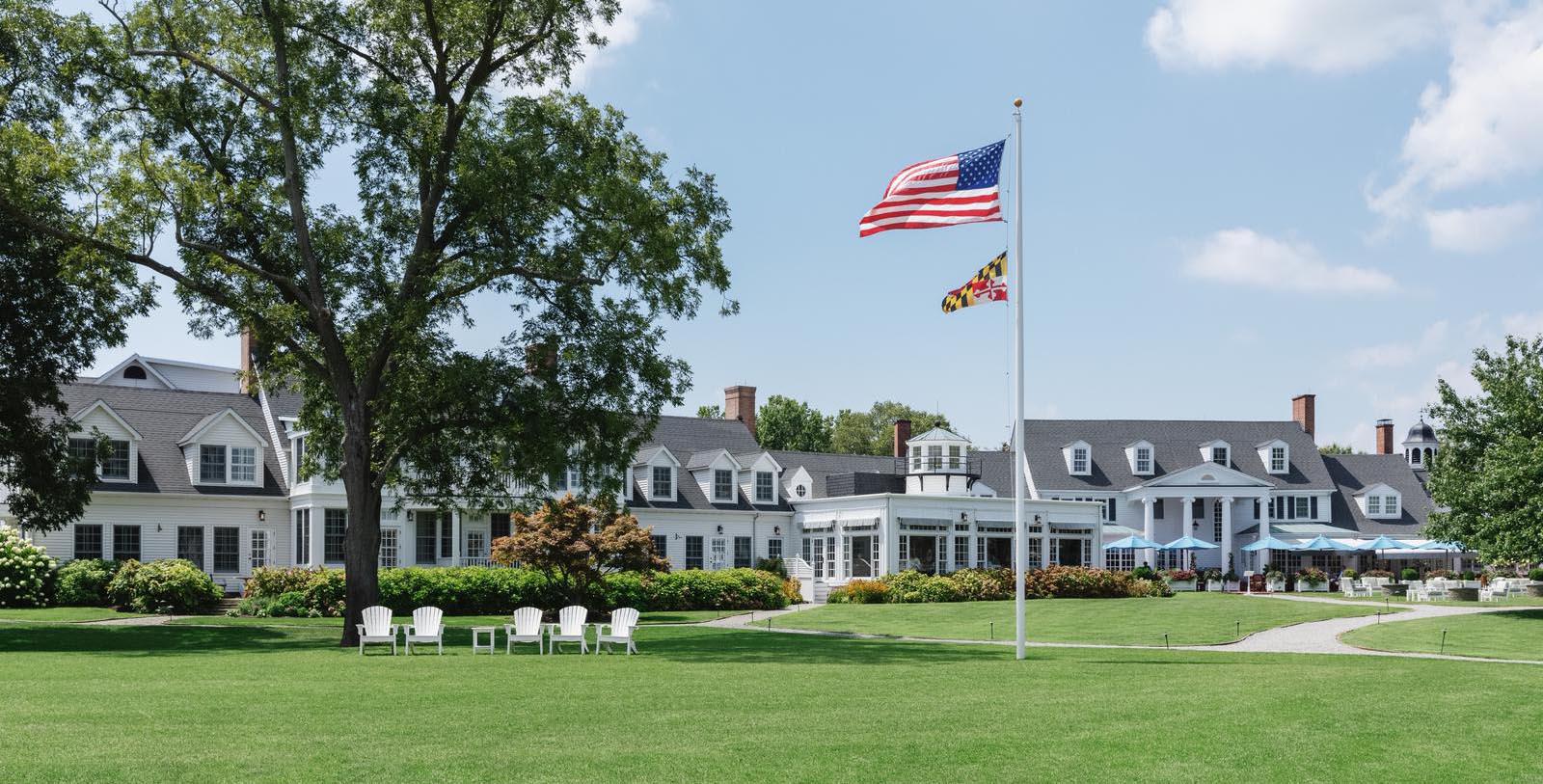Receive for Free - Discover & Explore eNewsletter monthly with advance notice of special offers, packages, and insider savings from 10% - 30% off Best Available Rates at selected hotels.
golf
Discover the Links at Perry Cabin, which was designed by legendary golf course architects Pete and Alice Dye.
Enjoy an exemplary golf course at the Inn at Perry Cabin, which the legendary Pete Dye designed. The Inn at Perry Cabin opened in 1816 and was inducted into Historic Hotels of America in 2018 – the same year that Dye’s magnificent golf course opened. Pete Dye, one of the greatest golf course architects of the late 20th and early 21st centuries, collaborated with his wife, Alice, and their son, P.B., to specifically create the Links at Perry Cabin. It is a work of art that provides a truly world-class golf experience for golfers of every level. The course plays through stunning topography and vistas of Maryland’s iconic Eastern Shore. Players voyage inland through lush woodlands and man-made dunes sculpted from the earth, before feeling the breeze off the water on the final stretch of holes. The game at the Inn at Perry Cabin is played among majestic trees, bunkers, and distinctive water features, ending with an unforgettable green within view of the glorious Chesapeake Bay. During the design process, Pete Dye agreed on three fundamental rules to guide every decision on this course: "keep it fun…keep it beautiful…keep it moving." No hole was routed, no green was built, and no tree was planted without consideration of these principles. Constructed on a peninsula where farms and flora meet the coastline, the Links highlights Pete Dye’s unique ability to sculpt fairways into natural expressions of the natural landscape itself.
Winding through indigenous trees and undulating terrain, the lush course is filled with inspiration from iconic Pete Dye golf holes—including the island green at TPC Sawgrass and the “Biarritz” hole on the Yale Golf Course. The last three holes at the Links will leave a particularly lasting impression. Believing the end of any course should be the most memorable, Pete designed the last greens to remain in the golfer’s mind long after the round has ended. Collectively referred to as the “good night kiss,” each are exciting, challenging, and fun in their own way. Be prepared for hole 17, a replica of Dye’s island green from his TPC Sawgrass course that is playfully known as a “Dye-abolical” island green. But before the Links at Perry Cabin opened in 2018, guests at the resort had access to another golf course on the same land with a connection to the Dyes. Nearly 50 years earlier, in the late 1960s, Pete Dye and his brother, Roy, started work at the site of the future Links course. Nevertheless, they were never paid for their efforts when the development plan fell through. The course, called the “Martingham Country Club”—and later called the “Harbourtowne Resort Country Club”—was finished without their input. Roy passed away in 1995, but Pete lived to see the Dye family’s vision for the course take root in the form of the Links in the 2010s. It was Pete Dye's final design. His son, P.B., can be credited with ensuring his father's ideas were brought to fruition.
-
About the Location +
St. Michaels first emerged amid the American Revolution, when British land agent James Braddock established a speculative street grid upon 20 acres he had purchased near the Miles River. Over time, the town became more of a reality, after settlers began constructing dwellings along Braddock’s basic plan. They soon took to calling it “St. Michaels” in honor of an Anglican church that had resided in the region years prior to the town’s founding. Nevertheless, the settlement’s earliest inhabitants were Methodist, giving St. Michaels a unique identity when compared to its neighboring communities. In fact, Braddock himself helped construct the Methodist church at the center of the town square. Even though the surrounding environs of Talbot County entertained a large agricultural economy, St. Michaels itself thrived on commerce generated from the Chesapeake Bay. Shipbuilding was one of the earliest industries to emerge, specifically servicing the fisherman that operated all along the state’s Eastern Shore. As many as six different craftsmen constructed commercial vessels shortly following the founding of the nation, building all sorts of small ships. The most prominent kind was a type of fast schooner that soon came to be known as the “Baltimore Clipper.” The Baltimore Clipper later rose to prominence during the War of 1812, as their speed and size made it easy to avoid British ships prowling the coast. Some Baltimore Clippers even acted as corsairs, harassing British merchant vessels as they attempted to cross the Atlantic. One resident named Thomas L. Haddaway was one such local who engaged in successful pirating raids, launching his own schooner mere days after war had been declared between the two countries.
St. Michaels played a much more prominent role in the War of 1812, when a fleet under the command of Admiral Sir George Cockburn sailed up the Chesapeake Bay. While the admiral’s ultimate objective was the District of Columbia, he struck at various defensive installations throughout the region first. Due to the presence of its vibrant shipyard and local battery of cannons, St. Michaels was among the places Sir Cockburn assaulted. In the early morning hours of August 10, 1813, Admiral Cockburn sent a landing party ashore to wreak havoc. With darkness covering their tracks, the British soldiers engaged a militia company just to the south of town. Scaring away the militia, the marines made short work of the cannons that protected the harbor. They then gave the signal for the main fleet to start bombarding the town. But the ships failed to do any substantial damage to either the town or its shipyard. Many stories abound of why Admiral Cockburn’s men botched their attempt to destroy St. Michaels. The most enduring attest to how its residents ingeniously hung lanterns on high tree branches as a means of confusing the British out at sea. Thinking the town to be further away, most of the sailors missed their shots. As such, St. Michaels earned the moniker as the “town that fooled the British.” By this point of the fight, several other militia units had heard the gunfire and raced their own ordinance to the site. A fierce firefight ensued between the British and the new, makeshift coastal batteries in St. Michaels. Despite being heavily outgunned and outnumbered, the American militia companies managed to turn away the greatest navy afloat at that time!
Shipbuilding had declined significantly by the mid-1800s, but a prosperous oyster fishing industry emerged in its wake. Crabbing and other kinds of commercialized fishing followed suit, too. With the dawn of the next century, every household had at least one person who engaged in some form of commercial fishing for employment. Dozens of boats owned by local fisherman were a common sight in the nearby channel of Eastern Bay. Shucking houses soon defined St. Michaels’ landscape, specifically along the immediate shoreline of the Miles River. One of the most prominent “shucking” businesses of the era was a crabmeat packing company called “Coulbourne and Jewett.” Entrepreneur Frederick Jewett ran the enterprise, becoming one of the first successful African American business owners in Talbot County. He made the firm incredibly prosperous by advertising the crabmeat with a five-level grading system that rated its size and quality. (Consumers had to pick from the following categories: regular, claw, backfin, lump, and special). The system proved so successful that every other crab fisher adopted it—it is even still in use today! In recent years, St. Michaels has emerged as one of Maryland’s exclusive vacation retreats. (The Inn at Perry Cabin has especially driven this development.) But the town is also home to many fascinating cultural attractions, including the Cannonball House, Sherwood Manor, Crooked Intention, and the Saint Michaels Historic District. All are listed on the National Register of Historic Places.
-
About the Architecture +
Pete Dye: Hailed as the most influential golf architect of the last half-century, architect Pete Dye has left a legacy on the golfing world. An avid golfer from a young age, Dye first played the sport competitively while in high school. He continued to golf when he enlisted in the United States military upon graduating. While stationed at Fort Bragg, Dye worked as the greenskeeper for the base’s golf course. He also met the prominent Donald Ross, who was then still serving as the main professional at Pinehurst Resort. The meeting greatly affected Dye’s passion for the game, which he kept following as a student at Rollins College. He subsequently met Alice Holliday O’Neal and the two were married not long thereafter. They eventually moved to her hometown of Indianapolis, Indiana, where he got a job selling policies with The Connecticut Mutual Life Insurance Company. Even though Ross thrived in insurance, he still loved golf dearly. He thus entered into numerous amateur championships in Indiana during the 1950s and built a considerable reputation for himself. He even used the experience to eventually compete in the 57th U.S. Open. Although Dye failed to advance deep in the tournament, he still finished ahead of future greats Jack Nicklaus and Arnold Palmer. In 1961, Dye decided to leave the insurance industry behind to pursue his passion for golf full-time. With close support of his wife, Dye specifically formed his own golf landscaping firm. Dye’s very first project involved creating a magnificent nine-hole course called “El Dorado,” which became notorious for its water hazards.
However, his first big project transpired when he obtained the commission to craft the marvelous 18-hole course at Crooked Stick Golf Club. Receiving rave reviews, Dye was soon earning numerous commissions all over the United States. Many of his designs soon became incredibly popular, including Harbour Town Golf Links, Whistling Straits, and the Ocean Course at Kiawah Island. His greatest accomplishment was the TPC at Sawgrass’ Stadium Course. Noted for its great difficulty, his par-three 17th hole has since been referred to as the “world’s most terrifying tee shot.” Much of Dye’s designs were inspired by Scottish design principles, namely the use of pot bunkers, wooden bulkheads, and small greens. But Dye also invented his own fascinating greenskeeping practices, too, such as the implementation of railroad ties to help hold down bunkers. Among the last courses that Dye designed with such principles were the Links at Perry Cabin. During the design process, Pete Dye agreed on three fundamental rules to guide every decision on this course: "keep it fun…keep it beautiful…keep it moving." Believing the end of any course should be the most memorable, Pete specifically designed the last greens to remain in the golfer’s mind long after the round has ended. Dye himself drew inspiration from his other renowned courses, such as the island green at TPC Sawgrass and the “Biarritz” hole within the Yale Golf Course. In fact, hole 17 was a replica of Dye’s island green from his TPC Sawgrass course, playfully known as a “Dye-abolical” island green.
































